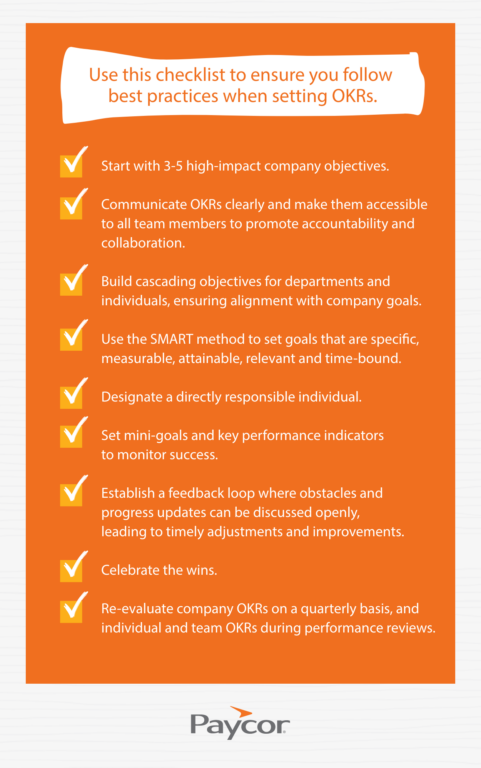The OKR (Objectives and Key Results) format for setting goals is a proven method companies use to achieve key business objectives. In simple terms, OKRs help leaders to put structure around a goal so that its achievement can be fast-tracked.
While their structure and what they contain are paramount, the key to their success is buy-in and alignment from every level of your organization.
To create an OKR, executives first set annual, quarterly or even monthly objectives. It is then up to managers to set performance goals for their teams. At that point employees can define their own individual objectives in relation to the OKR for which they’ll be held accountable.
An OKR can help a business achieve success on multiple levels. Let’s take a look at how you can help your team successfully set up OKRs.
How to Set OKRs: 7 Best Practices
Creating goals that inspire your people and produce results takes real skill. But it can be just as difficult for employees to find objectives that are measurable and align with the bigger picture of what the company is trying to achieve. If employees are new to OKRs, it can be easy to get overwhelmed. That’s why we’ve collected these tips:
1. Keep it Simple
Focus on objectives you know you can achieve in the given timeframe. Prioritize your objectives according to what the business needs most. Remember, there’s no magic number for how many objectives you should have—it depends how complex they are, as well as the time and resources available.
2. Be Specific
When setting objectives, brainstorm different ways you can reach the end result. Draw out your action plan to be more specific on how to achieve your objective. For each key result, think about how performance can be evaluated. The more specific you are, the clearer expectations will be. Concise objectives mean you’ll know exactly what’s needed to complete your goals.
3. Cascade Your Objectives
A common problem for employees setting objectives is struggling to see how their jobs contribute to overall organizational goals and success. How does a payroll clerk help their company reach 10,000 users? The solution is to cascade your objectives: from an organization level, to the department level and finally to an individual level.
When it comes to cascading objectives, communication proves critical. Leadership must communicate the company objectives and allow for questions and feedback. This enables departments and individuals to align their OKRs with company objectives.
4. Make it Measurable
Key results need a unit of measurement. It doesn’t matter what: it could be to write 10 blogs per month or to reach $10,000 in revenue. What you’re trying to avoid is a situation where you’re not sure whether a goal has really been reached or not. Managers and employees can meet 1:1 to add metrics to quantifiable goals.
5. Don’t Worry About Stretch Goals
Goals should be attainable yet challenging. Sometimes managers worry that easy goals will be demotivating. But are stretch goals a good idea? It all depends on how realistic they are. Ambitious goals are great, but don’t set employees up for failure.
6. Break Key Results into Smaller Goals
Create mini-goals within your key results. Knowing what you have to do to achieve your key results makes objectives more specific. These mini-goals act as milestones. But when goals are too broad, it can be hard to maintain focus on achieving them—these steps along the way help you stay on track.
7. Celebrate and Recognize
Reward and recognize yourself and others when a milestone has been reached no matter how early that happens in the overall process. Positive reinforcement helps sustain best practices. Don’t wait until the very end of an objective to recognize effort—celebrate incremental progress too. Encourage all co-workers to share their OKRs publicly and create a support system within your team.
Common Pitfalls to Avoid When Establishing OKRs
Mistakes to avoid when setting OKRs include:
- Lack of ownership: Even for organization or team OKRs, someone should be designated as the directly responsible individual (DRI) who will monitor progress and ensure objectives are met. Without someone held accountable, progress can come to a halt.
- Using OKRs as a checklist: While many tasks are required to achieve goals, OKRs are about the end result. Focusing too much on completing tasks (output) rather than achieving the desired impact (outcomes) often leads to less meaningful results.
- Too many objectives: Having too many OKRs can lead to dilution of focus and resources. Prioritize the most impactful objectives to maintain clarity and effectiveness. This focus ensures better resource allocation.
- Lack of alignment: Team and individual OKRs must be in harmony with company-level OKRs. Misalignment leads to siloed efforts. Ensuring all levels of the organization work toward the same overarching goals fosters collaboration and enhances overall efficiency.
- Vague objectives: Objectives must be specific or measurable, otherwise no one knows what they are working toward or how to measure success.

Frequently Asked Questions
Still have questions on the OKR goal setting framework? Check out these commonly asked questions and answers.
What Are OKRs in Business?
Objectives and Key Results are designed to drive teams to specific outcomes. The objectives are generally broad goals that provide direction and set the desired end state. The key results are quantifiable and detail what needs to be achieved to reach the objectives. Management develops initiatives and action plans to support the achievement of these key results, ensuring a clear and structured approach to reaching the overall objectives.
OKRs can be focused around:
- Growing revenue
- Increasing customer retention and growth
- Upgrading internal systems
- Improving marketplace positioning
- Increasing market awareness
What are Examples of OKRs?
It’s important to understand that while a company can have a set of OKRs, it’s not uncommon for units within the business to have ones as well, although these should be compatible with the company’s OKRs.
Sales teams may want OKRs to shorten the sales cycle, increase the average individual sale or improve customer satisfaction.
OKR examples for marketing teams may be to increase customer awareness, position the company as an industry thought leader or improve the brand’s public perception.
OKRs aren’t only created for external goals. The IT team can build an OKR that would help them to facilitate a system upgrade, launch an app or automate certain tasks.
How Do You Write an Individual OKR?
OKRs shouldn’t be constructed in an executive vacuum if you want them to be successful. Because OKRs are omni-directional tools, there should be input from all team members who might be affected.
Yes, this can create a lot of discussion and “I want to sees…” but the goal will be for you to keep the group focused on the goals that need to be met and then structuring the OKR to get there. Remember the more specific you can be, the better your chances of success.

Free Template
Get OKR examples to align employee priorities with company goals.
What Are the Primary Benefits of Implementing OKRs in an Organization?
OKRs provide a clear and concise framework for setting and communicating goals, which ensures everyone in the organization understands and works toward the same key priorities. Company OKRs create a collaborative environment, while individual OKRs empower employees to take ownership of their goals and contribute to the organization’s success.
How Should Objectives and Key Results Be Structured to Align with Company Goals?
When structuring OKRs, break down the company-wide objectives into cascading objectives for departments, teams and individuals. Each level should support the high-level objectives. Use the SMART method, which means OKRs should be:
- Specific: Clearly define what you want to achieve.
- Measurable: Set key performance indicators for how you plan to measure the OKR.
- Attainable: Make sure goals are realistic based on time and resources available.
- Relevant: Align OKRs with company needs and goals.
- Time-bound: Set a deadline.
How Often Should OKRs Be Reviewed and Updated?
OKRs should be reviewed quarterly to track progress, make necessary adjustments and ensure they remain relevant to the company’s evolving goals and market conditions. Upon review, communicate any changes and the rationale behind them to team members.
How Paycor Helps
Paycor understands how OKRs can help a business see success, which is why our Talent Development product is designed to help you develop and drive OKRs within a business unit or across the organization.
With Paycor, you can modernize every aspect of people management, from the way you recruit, onboard and develop your team, to the way you pay and retain them. See how Paycor can help the leaders of your organization solve the problems of today and tomorrow with a guided tour of our Talent Management software.









